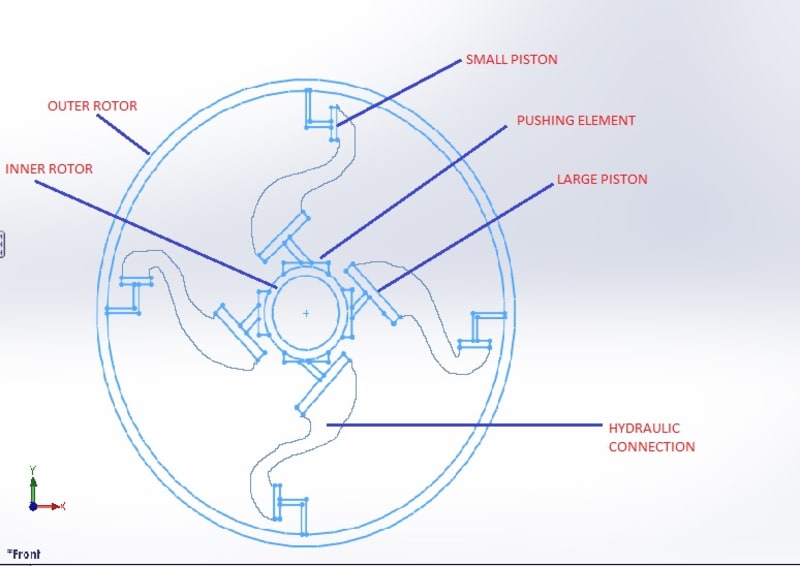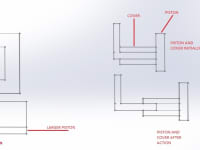Nigi torque multiplier as the name implies is a mechanism for multiplying torque. Consider two rotors coupled together. In normal case if these two rotors are connected together and allowed to rotate, then the same torque acting on the outer rotor would also act on the inner rotor. But if these two rotors are connected using Nigi torque multiplier mechanism then many times the torque acting on the outer rotor or input rotor would act on the inner rotor or output rotor. This is achieved using the principles of hydraulic force multiplication based on Pascal’s law. The input and output rotors are connected using hydraulic connections with two pistons at its ends; a piston of small cross-sectional area near to the larger rotor and a piston of cross-sectional area x times that of the smaller piston near to the inner rotor.
The smaller piston in the hydraulic connection is attached to the outer rotor in such a way that as the rotor rotates it exerts a force on the piston. Since the area of cross-section of larger piston is x times the area of cross-section of smaller piston, x times the force that acted on the smaller piston will be acted upon the pushing element attached to the larger piston by the larger piston. The pushing element stands held against the inner rotor. Hence the pushing element pushes the inner rotor to rotate with that force. Simultaneous application of multiplied forces from the four pushing elements makes the inner rotor rotate with a much greater torque than the outer rotor. Hence for a given input torque a multiplied output torque is obtained. All though four connections are shown in figure many more connections (depending on the design and construction) are possible to increase efficiency provided they don’t hinder with the working of mechanism.
An important part in the working of this mechanism is recoiling. After the application of force the larger piston recoils pulling back the pushing element and also pushes the smaller piston backwards. In order to prevent this from hindering the rotation of the two rotors, the smaller piston is attached to the connection from the outer rotor through a cover structure. So when the outer rotor while rotating pushes the smaller piston through the connection the smaller piston moves pulling the cover which slides over the connection and again during recoiling the cover slides back to its original position pulling piston with it. Any manufacturing tussle associated with this multiplier would seem light with regards to its usefulness.
This mechanism can be used in the drive train of a motorcycle or a normal cycle where the larger rotor would be coupled with the sprocket carrying chain and the smaller rotor coupled to the hub of wheel. This would aid in increasing the fuel efficiency of motorcycle or reducing the effort of cyclist. This innovation is not limited to automobiles and can be used on all devices where torque multiplication is rewarding.
Like this entry?
-
About the Entrant
- Name:Sreehari P V
- Type of entry:individual
- Software used for this entry:SOLID WORKS and paint
- Patent status:none





